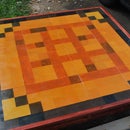Introduction: Barrel Furnace Build
I have a few stainless steel drums lying around the property. I decided I would take the prettiest one and make a furnace out of it.
This is the near completed first step of the drum furnace assembly.
I'm going to potentially add an additional radiator drum and cement in the imperfections for a better seal with this stuff: http://tinyurl.com/myzbrz9
Step 1: DRUM and SAFETY
Barrel stoves are a fun project. I've seen quite a few of these running around on youtube or on prepper sites. I really have wanted to build one of these for a while. In order to do this instructable, you'll need to get your own drum and your own door kit.
Got the kit here: http://www.tractorsupply.com/en/store/united-stat...
A word about drums.
Steel drums are a great project starting material. But, for this particular indication, your drum selection should be carefully scrutinized. The best advice is to get a new drum that has never contained anything: http://tinyurl.com/mmh3lh4. The important thing is that the drum was not used to contain an explosive or flammable liquid. If the drum was used to store oil or paint or the like, you may want to choose another drum to cut. Nobody wants to get blown up. Even if you're using a new drum, ensure you fill the bottom quarter or so with water. Use water in between cuts and drill events to cool your drum. It will get powerfully hot if you don't do this.
Personal protective equipment Needed:
- Safety Goggles
- Face Shield
- Gloves
- Long Sleeve Shirt (no loose sleeves)
- Fire Extinquisher (never hurts)
- Bucket of Water.
Tools
- Power Drill and Steel drilling bits
- Stainless Cutting Disc and rotary cutting tool (SkilSaw or Grinder)
- Pliers
- Ratchet or Socket Wrench
- Screwdrivers
Step 2: Rough in the Door
You'll want to make sure it looks pretty good. The issue with this particular drum is that it's nobby.
So there was only a very small margin for error. I used the the abrasive cutting wheel. It was a real nice tool. It throws some sparks though. PPE: Full arm coverage, and I recommend the goggles and face shield combo with ear protection. There are easier ways to cut this I bet, but I didn't have the most optimal tools or an oxyacetalyene torch so...
Also repeating PSA: Whenever you're cutting stainless or other metal drums: fill the bottom bit with water. Be VERY mindful of what the drum may have previously contained, as it might go boom and nobody wants that. Take some time between drilling and cutting to cool the metal with some water. Take your time and be really safe.
Step 3: Door Cut and Attaching
Here are more pretty pictures. With the door cut in, you'll be free to do your attachment drilling and anchoring. The kit is pretty great and comes with some nice bolts. You can probably see the convex shape of the drum head. In my case, I had to get a bit creative with the bolting and the socket wrench bend the steel in order to make a good seal.
Be extremely careful with the cut steel edges. It is incredibly sharp.
Step 4: Flue Insertion
Once the door was on, we attached the legs (not pictured). We leveled the door on the unattached legs and marked location on the bottom. Flipped, drilled, and attached legs.
Putting the unit back upright, we located the flue at the far end from the door. (This will become important later if you plan to do a second drum as a radiator).
Same procedure as before, use the flue insert, make the trace, get the cutting wheel and be super careful.
Step 5: Chimney!
Once the flue was cut it, and screwed on it was time to put on the temporary chimney.
Empty out the bits of metal and water that remain in the drum and get ready for your first test burn.
The test burn is very important. You'll be burning off the remnants of paint and whatever else may have been in your drum. It cannot be overstressed that this first burn should be long, and it should be done OUTSIDE away from any other flammable things. The smoke should be avoided during this burn. Once the first burn is done and the furnace is operating as you want it to, it can be located to it's intended operating location. Decent online guide to chimney locations. Definitely check your local fire codes before placing this type of construction anywhere within a structure. This guy is for my workshop.
Good luck! Be careful!

Participated in the
Teach It! Contest Sponsored by Dremel













